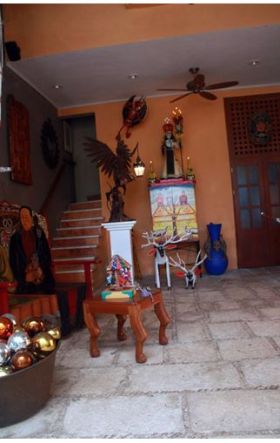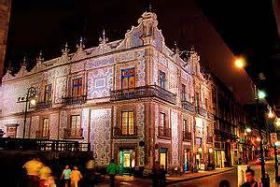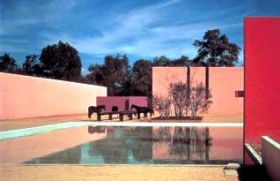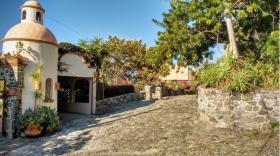How are the homes in Mexico different than in the US or Canada?
John Venator - Casa de los Venados
 Here in Mexico, if you see a newly constructed, expensive, and contemporary house it will look just it would have in Southern California.
Here in Mexico, if you see a newly constructed, expensive, and contemporary house it will look just it would have in Southern California.There are developments with 2 or 3 streets already and the developer contractor happens to be a friend of ours. Drive down that street, and you will think you are in Orange County. There are no big walls. There are no barbwires. They are literally front lawns and wonderful ranch style houses. However, that is an exception.
The...
 Here in Mexico, if you see a newly constructed, expensive, and contemporary house it will look just it would have in Southern California.
Here in Mexico, if you see a newly constructed, expensive, and contemporary house it will look just it would have in Southern California.There are developments with 2 or 3 streets already and the developer contractor happens to be a friend of ours. Drive down that street, and you will think you are in Orange County. There are no big walls. There are no barbwires. They are literally front lawns and wonderful ranch style houses. However, that is an exception.
The majority of houses where we live here in Valladolid, half way between Merida and Cancun in the Yucatan Peninsula, are old colonial stone buildings. Our house happens to have meter thick walls (39 inches). Our ceilings are 8 meters, which is a little untypical. The most typical from older colonial houses is 6 meters. 8 meters, by the way, is roughly 25 feet tall. However, none of our rooms are wider than 5 meters because that is the maximum length they would cut the vega (wooden poles) that help hold up your stone roof.
Within that footprint we did not remodel. We renovated because we added kitchens. We punched in doors. We added patios because the ceilings were so high. We actually added some second floors and some balconies in some areas. The majority of the houses here, in this town of roughly 80,000 people, are old colonial style stone buildings.
(Thick walls and ceilings of the Venator house in Valladolid, Mexico, pictured.)
Posted September 25, 2015
Oscar Hererra - SimplePay
 When thinking about the differences between the homes in Mexico and the US or Canada is that the homes here in Mexico are built differently. A lot of the houses in the US are built with wood but in Mexico most houses are built with brick. The main difference between houses in the US or Canada and the houses in Mexico are the materials used in building them. The finishes are pretty much the same.
When thinking about the differences between the homes in Mexico and the US or Canada is that the homes here in Mexico are built differently. A lot of the houses in the US are built with wood but in Mexico most houses are built with brick. The main difference between houses in the US or Canada and the houses in Mexico are the materials used in building them. The finishes are pretty much the same. You have access to hand made and custom-made things for your...
 When thinking about the differences between the homes in Mexico and the US or Canada is that the homes here in Mexico are built differently. A lot of the houses in the US are built with wood but in Mexico most houses are built with brick. The main difference between houses in the US or Canada and the houses in Mexico are the materials used in building them. The finishes are pretty much the same.
When thinking about the differences between the homes in Mexico and the US or Canada is that the homes here in Mexico are built differently. A lot of the houses in the US are built with wood but in Mexico most houses are built with brick. The main difference between houses in the US or Canada and the houses in Mexico are the materials used in building them. The finishes are pretty much the same. You have access to hand made and custom-made things for your house here in Mexico because labor is cheaper here. You can do fancier floors and walls and even fancier furniture that is custom-made because you have access to it. This is why Americans have either wood or iron custom furniture made for them here in Mexico; because it is cheaper.
Carpeting is very uncommon in Mexico. What’s common is tiled flooring. I don’t know why but I think we as Mexicans believe that carpets tend to get too dirty and tiled floors are cheaper. Also remember that a lot of the Mexican households have access to a maid for $30 every time she comes or $40 if you want to tip her. The average charge for a maid to clean a house like mine, which is a 2,400 square feet home, is $30 once a week, and she will do everything; all the cleaning. That is why people no longer worry about how much they have to clean because someone is going to clean for them. So going back to the carpeting, because we have access to cheap labor, I think it is cheaper to maintain tile than carpet.
(The Casa de los Azulejos is an 18th century palace made of tiles in Mexico City, Mexico, pictured.
Posted November 26, 2015
Mark O'Neill
 One of the items that affects how homes are built is the nature of the area, particularly in Ajijic, which has such a mild climate that National Geographic considered it the second finest climate in the world in which to live. The temperature in Ajijic ranges from 50 to 80 degrees year round, which does not demand that you build homes with extreme heating and air-cooling capabilities, as would be the case in many countries, including the US.
One of the items that affects how homes are built is the nature of the area, particularly in Ajijic, which has such a mild climate that National Geographic considered it the second finest climate in the world in which to live. The temperature in Ajijic ranges from 50 to 80 degrees year round, which does not demand that you build homes with extreme heating and air-cooling capabilities, as would be the case in many countries, including the US. In Ajijic,...
 One of the items that affects how homes are built is the nature of the area, particularly in Ajijic, which has such a mild climate that National Geographic considered it the second finest climate in the world in which to live. The temperature in Ajijic ranges from 50 to 80 degrees year round, which does not demand that you build homes with extreme heating and air-cooling capabilities, as would be the case in many countries, including the US.
One of the items that affects how homes are built is the nature of the area, particularly in Ajijic, which has such a mild climate that National Geographic considered it the second finest climate in the world in which to live. The temperature in Ajijic ranges from 50 to 80 degrees year round, which does not demand that you build homes with extreme heating and air-cooling capabilities, as would be the case in many countries, including the US. In Ajijic, they use very simple construction techniques. My property does not have even a stick in the construction of the entire property aside for some wood accents. Homes in Mexico are made of stone, mortar, and cement, which have some wonderful thermal characteristics. When you use those materials you don’t have to put insulation on the wall between two by fours because your wall is 12 or 18 inches thick of solid cement, brick or stone.
The homes here are very environmentally friendly and the methods of repair and construction are very simple, as they are mostly brick and stone, which allow the local artisans to build things in a very economical manner compared to the houses in the US. As an example, my architect, with whom I helped coordinate with the original owners for modifications, controlled the whole process where everything is set up. Down in Mexico, it’s all under one roof, and it’s all taken care of. The simplicity yet efficiency of their construction detail and techniques is embracing. Because of them, the properties that are built here have quality that would last for you, for your kids, and your grandkids.
(Stone church in Ajijic, Mexico, pictured.)
Posted June 29, 2016
Karen Herrtwich - S&S Auto
 Most homes in Mexico are made of concrete. Most homes in the US and Canada are built with wood and drywall. Salitre (bubbling in the concrete) can be a problem here – this is typical with the majority of homes here.
Most homes in Mexico are made of concrete. Most homes in the US and Canada are built with wood and drywall. Salitre (bubbling in the concrete) can be a problem here – this is typical with the majority of homes here. However, the builders in Mexico can pretty much form anything you want with concrete. I've showed them a picture in a magazine of a fireplace design I wanted, and that is the fireplace design I got.
In...
 Most homes in Mexico are made of concrete. Most homes in the US and Canada are built with wood and drywall. Salitre (bubbling in the concrete) can be a problem here – this is typical with the majority of homes here.
Most homes in Mexico are made of concrete. Most homes in the US and Canada are built with wood and drywall. Salitre (bubbling in the concrete) can be a problem here – this is typical with the majority of homes here. However, the builders in Mexico can pretty much form anything you want with concrete. I've showed them a picture in a magazine of a fireplace design I wanted, and that is the fireplace design I got.
In Mexico, we don't have basements. We have footings that might go down 2-3 feet into the ground.
The architecture of the homes in Mexico differs from the architecture of homes in the US and Canada, too. Homes in Mexico have this colonial touch. The colonial look is where there are lots of arches, beautiful moldings, and colorful tiles. Mexicans also love modern architecture, so houses are often very square and neat.
(Modern home with pool, Mexico, pictured.)
Posted March 16, 2017
Mark Eager - Eager & Asociados
 I’ve built homes in Mexico that are totally different than the homes in Canada. For instance, in Canada, we have frost levels and have to go down six feet to meet the frost levels so the homes don’t crack apart. Here in Mexico, you don’t have to worry about frost levels. It’s like night and day, because we don’t use stud walls. Drywall is becoming more and more familiar.
I’ve built homes in Mexico that are totally different than the homes in Canada. For instance, in Canada, we have frost levels and have to go down six feet to meet the frost levels so the homes don’t crack apart. Here in Mexico, you don’t have to worry about frost levels. It’s like night and day, because we don’t use stud walls. Drywall is becoming more and more familiar. If you went to Guadalajara, in all the high rises...
 I’ve built homes in Mexico that are totally different than the homes in Canada. For instance, in Canada, we have frost levels and have to go down six feet to meet the frost levels so the homes don’t crack apart. Here in Mexico, you don’t have to worry about frost levels. It’s like night and day, because we don’t use stud walls. Drywall is becoming more and more familiar.
I’ve built homes in Mexico that are totally different than the homes in Canada. For instance, in Canada, we have frost levels and have to go down six feet to meet the frost levels so the homes don’t crack apart. Here in Mexico, you don’t have to worry about frost levels. It’s like night and day, because we don’t use stud walls. Drywall is becoming more and more familiar. If you went to Guadalajara, in all the high rises you see there, there could be a lot of light density block, drywall, or the steel beams. Here in the Lake Chapala area, we have concrete, rock, cement, plaster, bottle products that protect the roof, and sealants. It’s a totally different culture when it comes to building the actual structure of the house.
When it comes to electricity and plumbing, homes in Mexico and homes in the US or Canada are very similar. Even though we don’t have studs here in Mexico, we drill the holes through and run the copper plumbing across the floors and up into the wall. The electrical is still the same, done in a different form because we’re using solid masses instead of wood and other forms.
The homes here in Mexico, compared to where I came from in Canada, are built extremely well. Once they’re built, they’re there. It’s two different worlds when it comes to construction. The houses in Mexico are built better and last longer. They’re fireproof. A lot of people have home insurance here, and I recommend it although I don’t have house insurance on mine. I have life insurance, car insurance and health insurance. If I was in the beach, because of the hurricanes, or if I was in Mexico City or in a place that’s more prone to earthquakes, then I’d be stepping up to the bat a little bit more.
I know one person whose house burned down. She used to work for me, and she had a wooden roofed house, which is very rare. She lit a Christmas tree on fire, but after the fire all her walls were still standing. What burnt out was the roof.
(Stone, cement and brick construction, Ajijic, Mexico,pictured.)
Posted May 25, 2017



.png)